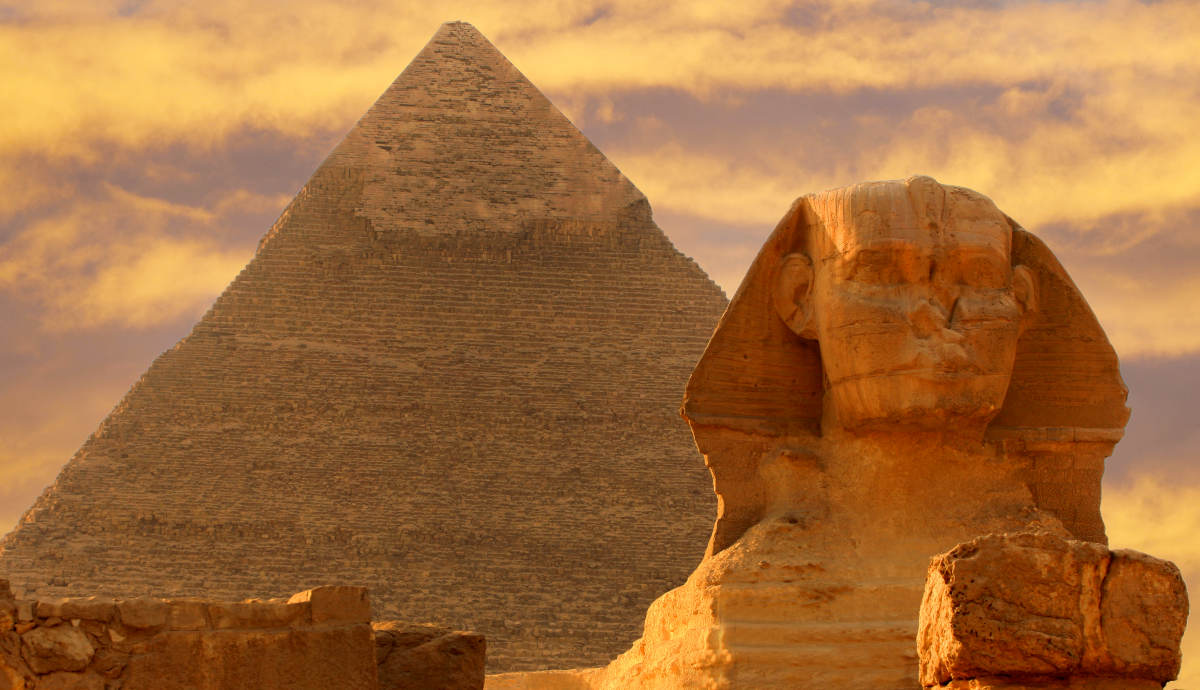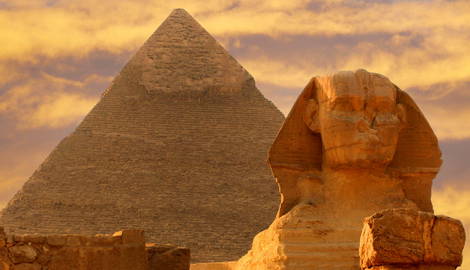
Many wonders of ancient Egyptian civilization remain standing after more than three millennia. These monuments are some of the most popular and enduring landmarks for tourists from all over the world.
Archeologists and adventurers have dedicated their lives to finding stories of these great temples, statues, tombs, and the pharaohs that built them. Below you’ll find a list of 11 of the greatest ancient monuments Egypt has to offer.
11. The Colossi of Memnon

The Colossi of Memnon are two 20 meters tall representations of pharaoh Amenhotep III. The sitting statues were part of his mortuary temple that was destroyed over time. The Colossi now form part of the Theban Necropolis on the east bank of the Nile at Luxor.

The Colossi are composed of large, heavy pieces of stone that lie on the top of each other without using mortar to bind them. The Colossi stone were restored numerous times, including by Roman Emperor Septimius Severus. More recently, they have been endangered by pollution and wear, so are being supported to limit further deterioration and prevent them from tumbling down. Memnon comes from the Greeks, who honored their hero of the Trojan War by renaming the monument after him.
10. The Valley of The Kings

The Valley of the Kings lies on the Nile’s west bank near Luxor and is the cemetery for the pharaohs of Ancient Egypt’s New Kingdom (1539 – 1075 BCE).
Many different tombs of the elite from this period have been discovered in the desert valley, ranging in size from single coffins to elaborate underground tombs housing entire families on their journey to the afterlife.

The most famous tomb from the Valley of the Kings is that of the boy King Tutankhamun, found intact by British archeologist Howard Carter in 1922. Later pharaohs such as Horemheb and Ramesses II (both buried close by) tried to have Tutankhamun removed from Egypt’s histories, which meant robbers and adventurers were unable to disturb his tomb for almost 3500 years.
9. Temple of Edfu

The Temple of Edfu was built during the Ptolemaic Kingdom, the period covering Egypt from the death of Alexander the Great to that of Cleopatra and Rome. Edfu is dedicated to Horus, the god of kings and the sky, and his consort Hathor.

Edfu fell into disuse as a temple during the latter stages of the 4th century due to the rise of Christianity and the Church’s need to stamp down on paganism. The hypostyle hall was burnt badly by arson, and many reliefs defaced. Edfu was eventually built over by villagers and nearly buried.
Edfu is now a popular destination for the large luxury riverboats and small, simple Felucca craft that navigate the Nile between Luxor and Aswan.
8. The Step Pyramid of Djoser

The Step Pyramid of Djoser was the very first pyramid built by the Ancient Egyptians. Standing nearly 62 meters tall it was the earliest large monument built with stone, an architectural feat different in scope to the mud-brick construction of earlier royal tombs.

Djoser decided that his tomb would be at Saqqara, near the royal capital Memphis where he lived. The Step Pyramid was originally a mastaba tomb, an underground burial chamber with ground level rooms above to store gifts and offerings to the pharaoh.
Djoser’s Royal Architect Imhotep built on the mastaba to make the Step Pyramid look like a giant staircase, so the spirit of his king could get closer to the sun during his journey in the afterlife.
7. Luxor Temple

The Luxor Temple was utilized by New Kingdom pharaohs to revitalize their kingship before the gods. Amenhotep III and Ramesses II created monuments to worship the celebration of Opet, the festival in which gods Amun, Maat, and Khons made their ritual journey from their Karnak shrine to the Temple of Luxor and remained there for 24 days while the city celebrated.

Notable monuments within Luxor Temple include the Colonnade of Amenhotep III, the Great Court of Ramesses II, the First Pylon, and the Standing Statue of Ramesses II.
6. The Bent Pyramid and Red Pyramid of Sneferu

Sneferu was first pharaoh of Ancient Egypt’s 4th Dynasty and the father of Khufu (see below). He ruled for approximately 50 years which gave him the opportunity to build three pyramids, two of which are at Dahshur.
The Bent Pyramid got its name because architects realized they were building the pyramid too steeply and had to change the angle. Halfway up the sides the pyramid changes shape, making it look bent. It was made of large limestone blocks and rendered with better quality smooth limestone that can still be seen on the outer walls.

The second is called the Red Pyramid because the limestone’s oxidation gives it a noticeable reddish color. It was originally covered with white limestone, but because the structure was a perfect pyramid the sides were flat enough for robbers to walk along the surface easily and steal the white stone, leaving only the red behind.
5. The Mortuary Temple of Hatshepsut

The Mortuary Temple of Hatshepsut was constructed in the 18th Dynasty of Ancient Egypt and can be found close to The Valley of The Kings on the West Bank of the Nile, below the rugged cliff face at Deir el Bahari.

Her mortuary temple was designed for her by Royal Architect Senenmut and dedicated to the god Amun.
Hatshepsut was a rarity; a female Pharaoh, regarded by scholars as history’s first “great lady.” She ruled for nearly two decades before inadvertently poisoning herself when attempting to treat a hereditary skin condition.
4. Karnak Temple

Karnak was the central site of worship for Amun-Ra and is one of the most holy places in Egypt.
The complex was center for festivals in the city of Thebes (now Luxor). It was built on, added to, and changed over the more than 2000 years of continuous use. Rebel king Akhenaten even built a temple to Aten at Karnak however was torn down by Horemheb, and later Ramesses II.

Featured monuments at Karnak include the Hypostyle Hall, the Obelisk of Thutmose I, Hatshepsut’s Obelisk, The Great Edict of Horemheb, and the Avenue of Sphinxes.
3. The Great Sphinx, Giza

The Great Sphinx at Giza is Ancient Egypt’s most unique monument. Its speculated 4th Dynasty Pharaoh Khafre built the mythical creature from a massive rock by adding his face and giving it the body of a lion, as the Sphinx lies close to his valley temple complex and the causeway leading to his Pyramid (see below).

Tall tales once suggested the muskets of Napoleon Bonaparte’s soldiers in the 1700s blew off the Sphinx’s nose, however the likely scenario was its removal by Muslim factions in the late 1300’s who defaced the stone to stop local farmers from giving offerings to the statue.
2. Abu Simbel

The mighty Abu Simbel temple was carved directly into rock by Ramesses the Great at the peak of the 19th Dynasty as a reminder to Ancient Egypt’s Nubian territory that he was to be worshipped as a living god.

Four 20 meters tall Colossi of Rameses II dominate the small entrance to the Great Temple, where inside hieroglyphs of Rameses II feature him in the Battle of Kadesh, or communing with gods Ra-Harakhty, Amun Ra, Ptah, and Rameses II himself.
The Small Temple features 10 meters high statues of Rameses II’s wife Queen Nefertari and was built in worship of sky goddess Hathor.
1. The Great Pyramids of Giza

The Great Pyramid necropolis of Giza rises from amidst its Cairo surrounds to astound visiting travelers. The Great Pyramid is the largest of three, constructed by Khufu (known as Cheops by the Greeks) during the 4th Dynasty of Ancient Egypt.
The 139 meters tall Great Pyramid took over twenty years to complete. An estimated 100,000 skilled craftsmen were employed, and the project used in excess of 2.3 million stone blocks. It is the sole wonder left standing from those included in the Seven Wonders of the World.

The second Pyramid was built by Khufu’s son Khafre and stands 136 meters tall. It looks to be the largest of the three but was built at higher elevation. The third and smallest pyramid (65 meters) was constructed by Menkaure and completed around 2510 BCE.









